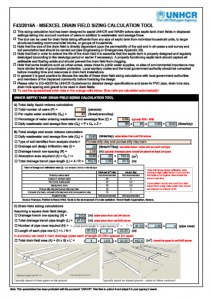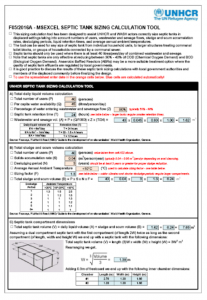 |
D-304/2015a Post Emergency Borehole Design (Fractured Rock Aquifer)This document contains a simplified design to help UNHCR and WASH actors design drilled boreholes (fractured rock) in refugee settings. The package includes: Technical Drawings; Step by Step Construction Drawings; Bills of Quantity; Material and Workmanship Specifications; and Design Calculations.
|
 |
F-402/2016a Drain Field Sizing Spreadsheet (UNHCR, 2016)This sizing calculation tool has been designed to assist UNHCR and WASH actors correctly size drain fields for septic tanks in displaced settings taking into account numbers of users, soil type, and wastewater and sewage flows.
|
 |
F-800/2015a Sample WASH Staffing Structure for Post Emergency Camp Setting (UNHCR, 2015)A sample organigram for running a typical refugee WASH programme for 20,000 people in a post emergency camp based setting. The organigram gives an indication of how the WASH Team should be structured in addition to the tentative number of Coordinators, Team Leaders, Officer, and Assistant level staff that should be recruited.
|
 |
F-302/2015a Well Cleaning and Chlorination Log Sheet (UNHCR, 2015)This is the standard UNHCR well cleaning and chlorination template for refugee settings available in PDF and MSExcel formats. The form should be completed each time a hand dug well is cleaned, chlorinated and tested for faecal coliforms. The form is available in MSExcel format so WASH actors can adapt the content to the context.
|
 |
F-503/2015a UNHCR Landfill Waste Register (UNHCR, 2015)UNHCR field staff and their partners should use this waste register form to keep a record of the types and quantities of waste being disposed at each landfill facility. Ideally waste management short, medium and long term strategies for different waste streams should be re-evaluated and re-organised based on the data collected from this tool. |
 |
F-401/2016a Septic Tank Sizing Spreadsheet (UNHCR, 2016)This sizing calculation tool has been designed to assist UNHCR and WASH actors correctly size septic tanks in displaced settings taking into account numbers of users, wastewater and sewage flows, sludge and scum accumulation rates, desludging periods, liquid retention times, and average annual ambient temperatures.
|
 |
F-200/2015a Summary of Important WASH Diseases in Refugee Settings (UNHCR, 2015)This document provides a quick summary of the most important WASH related diseases for refugee settings and includes a list of recommended control strategies.
|
 |
F-105/2015a Site Level Refugee WASH Operational Plan Template (UNHCR, 2015)This template can be used to help UNHCR and WASH actors establish a simple WASH operational plan (WHO will do WHAT, WHERE, WHEN, and HOW and WHO will PAY and WHO will MONITOR). This template can be used in addition to the site level WASH Strategy Template.
|
 |
Sphere Minimum Standards and Indicators for Humanitarian Response (SPHERE, 2011)The Sphere Handbook is one of the most widely known and internationally recognized sets of common principles and universal minimum standards for the delivery of quality humanitarian response.
|
 English
English